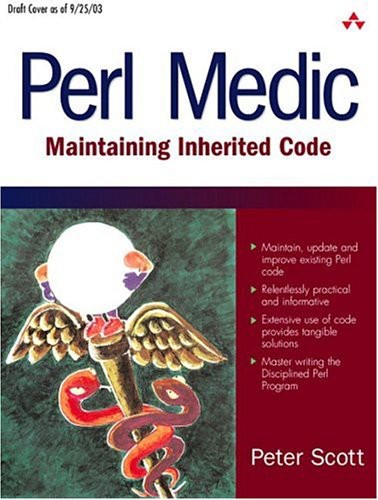

Most ebook files are in PDF format, so you can easily read them using various software such as Foxit Reader or directly on the Google Chrome browser.
Some ebook files are released by publishers in other formats such as .awz, .mobi, .epub, .fb2, etc. You may need to install specific software to read these formats on mobile/PC, such as Calibre.
Please read the tutorial at this link: https://ebookbell.com/faq
We offer FREE conversion to the popular formats you request; however, this may take some time. Therefore, right after payment, please email us, and we will try to provide the service as quickly as possible.
For some exceptional file formats or broken links (if any), please refrain from opening any disputes. Instead, email us first, and we will try to assist within a maximum of 6 hours.
EbookBell Team

0.0
0 reviewsThis book is about taking over Perl code, whether written by someone else or by yourself at an earlier time. Developers regularly estimate that they spend 60 to 80 percent of their time working with existing code. Many problems of code inheritance are common to all languages, but the nature of the language makes Perl especially tricky. The reason why is that Perl is similar to English - bursting with irregular verbs, consistent only when it's convenient, borrowing terms from other languages, and providing many ways to say the same thing. In fact, Perl developers have a motto with the abbreviation TMTOWTDI: There's More Than One Way To Do It. While this flexibility is one of the language's strengths, it also makes it extremely difficult when you are faced with an existing piece of code. There are millions of lines of Perl code being used all over the Web; much of it was built on an ad hoc basis, the creators never imagining that the code would still be in use months or years later. This book will be the resource all Perl programmers need to understand someone else's code, even when it's bad; repair it; convert it to a better style; upgrade it to the latest version of Perl; maintain it; and find and fix its bugs.
Amazon.com ReviewPerl ranks among hackers' favorite languages--there's always another approach to a problem, always optimization to be done, and forever new techniques to try. Perl's a hoot. But the culture of tinkering that surrounds Perl has resulted in a large body of hard-to-understand legacy code. That legacy code has to be maintained, extended, and adapted to new conditions--often without the help of the person who originally created it. Perl Medic considers Perl from the perspective of a programmer looking at code written by someone else and trying to answer the ancient question: "What were they thinking?"
It's a creative approach, and one that makes good reading for someone well-versed in Perl programming (author Peter Scott makes the analogy of becoming fluent in a human language, such as French, then studying its various accents and dialects). He shows, for example, a kludgy piece of code that's meant to catch CGI form uploads, then indicates that the obvious replacement is the CGI.pm module. Elsewhere, Scott shows why symbolic references are bad, and how to avoid them by means of hashes. Some of the value in this book is in the form of documentation of the differences among Perl versions; other useful coverage deals with warnings and strictness control as debugging tools. Read this straight through to improve your own code; use the index to help decipher and improve what someone else has written. --David Wall
Topics covered: How to write good Perl code, read bad Perl code, and convert bad Perl code into good in less time that would be required to write an equivalent replacement program from scratch. Testing, debugging, documenting, replacing custom code with CPAN modules, and embracing features that became available in later versions of Perl are all covered. Overall, the author endorses and generally explains the principles of Extreme Programming (XP) for Perl work.
From the Back CoverIf you code in Perl, you need to read this book.—Adam Turoff, Technical Editor, The Perl Review.
Perl Medic is more than a book. It is a well-crafted strategy for approaching, updating, and furthering the cause of inherited Perl programs.—Allen Wyke, co-author of several computer books including JavaScript Unleashed and Pure JavaScript.
Scott's explanations of complex material are smooth and deceptively simple. He knows his subject matter and his craft-he makes it look easy. Scott remains relentless practical-even the 'Analysis' chapter is filled with code and tests to run.—Dan Livingston, author of several computer books including Advanced Flash 5: Actionscript in Action
Bring new power, performance, and scalability to your existing Perl code!
Today's Perl developers spend 60-80% of their time working with existing Perl code. Now, there's a start-to-finish guide to understanding that code, maintaining it, updating it, and refactoring it for maximum performance and reliability. Peter J. Scott, lead author of Perl Debugged, has written the first systematic guide to Perl software engineering. Through extensive examples, he shows how to bring powerful discipline, consistency, and structure to any Perl program-new or old. You'll discover how to:
If you've ever inherited Perl code that's hard to maintain, if you write Perl code others will read, if you want to write code that'll be easier for you to maintain, the book that comes to your rescue is Perl Medic.
On the Web Site
Download all of the book's sample code from .